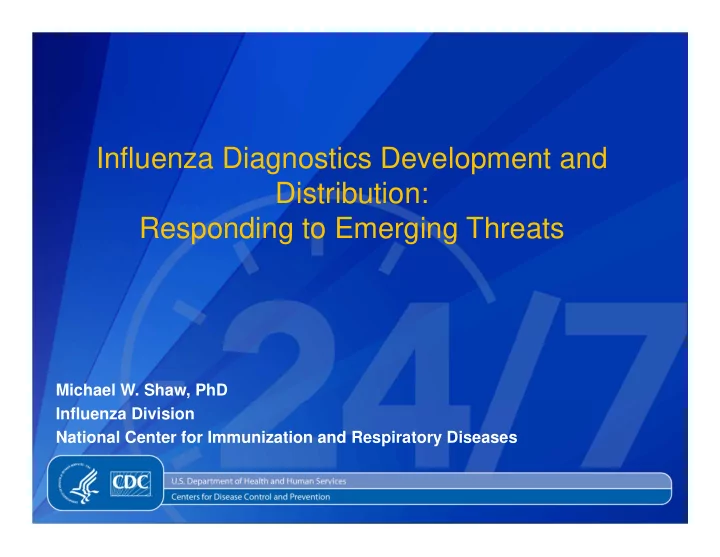

Influenza Diagnostics Development and Distribution: Responding to Emerging Threats Michael W. Shaw, PhD Influenza Division National Center for Immunization and Respiratory Diseases
Actions for Diagnostic Preparedness: • Develop New Diagnostic Tests and Improved Diagnostic Capabilities • Improve Surge Capacity • Implement Challenge and Proficiency Testing • Develop Regulatory Preparedness • Improve Access to Tests and Reagents • Provide Guidance for Clinicians • Improve Virologic Surveillance
What Tests are Needed and Where Do We Use Them? Antigenic Characterization (Determine Vaccine Match) CURRENT Virus Culture TESTS Serology (Antibody Immunofluorescence (Virus Detection) Detection) Real-time RT-PCR Immunoassay (Identification of Virus) (Virus Detection) SETTINGS Public WHO TEST Hospital Referral Outpatient Health Lab Lab & Clinic (GISRS) Lab Improved Laboratory Influenza Point-of-Care Test DEVELOPMENT Influenza Tests TESTS IN Rapid Influenza Immunity Test Antiviral Resistance Influenza Test
Gaps in Influenza Diagnostic Testing • No simple, rapid test available for use in point-of-care clinical setting to differentiate novel influenza from seasonal strains • Confirmation of subtype requires submission of specimens to a laboratory capable of running high-complexity tests • Current rapid tests are not easily adaptable for inclusion of new, variant strains • No tests available for antiviral resistance suitable for patient care decisions
Real-Time RT-PCR for Influenza Real-Time RT-PCR for Influenza • Based on CDC Assay cleared by FDA for • Based on CDC Assay cleared by FDA for domestic US use domestic US use • Capable of detecting all influenza A and B • Capable of detecting all influenza A and B • Identifies Influenza A subtypes: • Identifies Influenza A subtypes: • Seasonal H1 and H3 • Seasonal H1 and H3 • Novel subtypes as needed • Novel subtypes as needed • H5 • H5 • H7 • H7 • Internal Controls to test quality of specimen and • Internal Controls to test quality of specimen and proper test conditions – ensures test is valid proper test conditions – ensures test is valid High-complexity assay only suitable for labs with High-complexity assay only suitable for labs with appropriate equipment and trained personnel appropriate equipment and trained personnel
The Influenza Reagent Resource (IRR): A global CDC resource for public health laboratories • Goals: • Support global influenza surveillance by supplying high quality test kits for the detection and characterization of Research and influenza Development • Ensure high quality reagents are the standard for influenza research and the development of new influenza IRR diagnostics, vaccines, and therapeutics Virus Surveillance
Registrants order reagents through an email box (FluOrder@CDC.Gov) or web (http://influenzareagentresource.org)
As of Summer, 2013, the CDC IRR has distributed over 16,000 reagents to 665 laboratories in 161 countries New diagnostic tests and reagents are developed and distributed as needed when new virus variants appear.
First cases in Mexico: Late February–Early March April 15 April 29 May 3 May 23 First case First Diagnostic First Diagnostic Vaccine Strain Identified Kits Shipped to Kits Shipped to Shipped to A/California/4/2009 State Labs WHO Network Manufacturers
Timeline for Response to 2009 H1N1 Pandemic: April 15 April 29 May 3 May 23 First case First Diagnostic First Diagnostic Vaccine Strain Identified Kits Shipped to Kits Shipped to Shipped to A/California/4/2009 State Labs WHO Network Manufacturers Timeline for Response to 2013 H7N9 Outbreak: April 11 April 25 May 2 March 31 First H7N9 Virus First Diagnostic Vaccine Strain Novel Virus Identified, Kits Shipped Shipped to Shipped to CDC Sequences Made Public Manufacturers By China CDC By China CDC
CDC H7 rRT-PCR Kit Shipments (As of 26 July, 2013) # of US # of # of # of US # of Domestic International International Domestic Labs Countries Requests Requests Labs 109 108 78 73 69 Shipped 1 1 11 11 11 Pending 110 109 89 84 80 Total
CDC Protocol Availability • CDC protocols including all primer and probe sequences posted on WHO website (http://www.who.int/influenza/resources/en/) : • Real-time RT-PCR diagnosis influenza • Pyrosequencing for markers of antiviral sensitivity/resistance • Full genome sequencing of influenza viruses • REGULAR UPDATES AS PROTOCOLS MODIFIED TO IMPROVE PERFORMANCE • Laboratories worldwide have used these to develop their own testing protocols
The IRR stocks many influenza specific reagents • rRT-PCR kits and reagents • WHO test kits to identify influenza • Reference influenza viruses • Antibodies to detect influenza • Virus and antibody assay reagents • Sequencing reagents • Standards for test development Who can receive IRR reagents? • Qualified public health laboratories and WHO National Influenza Centers • Non-NIC public health and other non-profit laboratories are considered on a case-by-case basis
How are reagents distributed to users? • All products are provided free of charge, the IRR does not cover customs fees • International shipments are delivered within 2 weeks to most locations • Customer support is available at Contact@InfluenzaReagentResource.org • Customer support is managed by CDC and ATCC • Technical support for rRT-PCR diagnostics is available at FluSupport@CDC.gov • Technical support is managed by CDC • Technical support for other reagents is available by contacting CDC subject matter experts
Conclusions Influenza is both a recurrent, seasonal disease and a proven, emergent threat requiring constant international surveillance. The natural variation of influenza viruses means diagnostic tests must be updated frequently to detect newly emergent strains. Because influenza can spread rapidly both in human and animal hosts, public health laboratories need access to the most current tests as quickly as possible.
Thank You Michael W. Shaw MShaw1@cdc.gov www.cdc.gov. 1 ‐ 800 ‐ CDC ‐ INFO
Recommend
More recommend